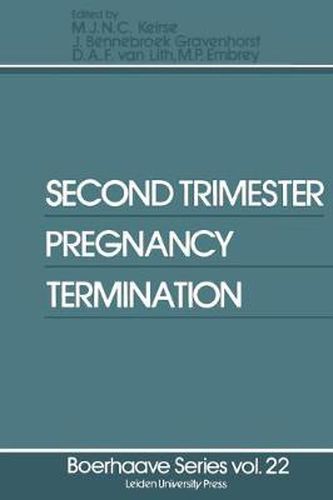Readings Newsletter
Become a Readings Member to make your shopping experience even easier.
Sign in or sign up for free!
You’re not far away from qualifying for FREE standard shipping within Australia
You’ve qualified for FREE standard shipping within Australia
The cart is loading…






This title is printed to order. This book may have been self-published. If so, we cannot guarantee the quality of the content. In the main most books will have gone through the editing process however some may not. We therefore suggest that you be aware of this before ordering this book. If in doubt check either the author or publisher’s details as we are unable to accept any returns unless they are faulty. Please contact us if you have any questions.
Views and attitudes. towards termination of pregnancy have shown con siderable evolution over the past few decades. Along with these changes has come a growing concern to adopt means and methods which could make termination easier, safer and more effective. In this evolution, termination in the second trimester in par~icular is notable as being responsible for a dis proportionate share ofthe complications and adverse experiences associated with pregnancy termination. Although the almost universal shift towards earlier abortion has reduced the number of second trimester procedures as a percentage of the whole, the problems of interrupting pregnancy in the second trimester remain conspicuous. Delay in either seeking or obtaining abortion is still, in many parts of the world, all too frequent. AdditiDnally, recent developments in the prenatal diagnosis of fetal malformations, alphafeto protein screening programmes and changes in the pattern of and approaches to intrauterine fetal death now also place greater emphasis on the need for adequate methods of interrupting pregnancy in the second trimester. Unlike the first trimester in which vacuum aspiration is universally con sidered to be the method of choice, in the second trimester of pregnancy the clinician is faced with alternatives; one method may be more appropriate than another in a particular circumstance and no single method is unequivocall~ accepted as best. Neither do second trimester terminations form a neatly defined single category.
$9.00 standard shipping within Australia
FREE standard shipping within Australia for orders over $100.00
Express & International shipping calculated at checkout
Stock availability can be subject to change without notice. We recommend calling the shop or contacting our online team to check availability of low stock items. Please see our Shopping Online page for more details.
This title is printed to order. This book may have been self-published. If so, we cannot guarantee the quality of the content. In the main most books will have gone through the editing process however some may not. We therefore suggest that you be aware of this before ordering this book. If in doubt check either the author or publisher’s details as we are unable to accept any returns unless they are faulty. Please contact us if you have any questions.
Views and attitudes. towards termination of pregnancy have shown con siderable evolution over the past few decades. Along with these changes has come a growing concern to adopt means and methods which could make termination easier, safer and more effective. In this evolution, termination in the second trimester in par~icular is notable as being responsible for a dis proportionate share ofthe complications and adverse experiences associated with pregnancy termination. Although the almost universal shift towards earlier abortion has reduced the number of second trimester procedures as a percentage of the whole, the problems of interrupting pregnancy in the second trimester remain conspicuous. Delay in either seeking or obtaining abortion is still, in many parts of the world, all too frequent. AdditiDnally, recent developments in the prenatal diagnosis of fetal malformations, alphafeto protein screening programmes and changes in the pattern of and approaches to intrauterine fetal death now also place greater emphasis on the need for adequate methods of interrupting pregnancy in the second trimester. Unlike the first trimester in which vacuum aspiration is universally con sidered to be the method of choice, in the second trimester of pregnancy the clinician is faced with alternatives; one method may be more appropriate than another in a particular circumstance and no single method is unequivocall~ accepted as best. Neither do second trimester terminations form a neatly defined single category.